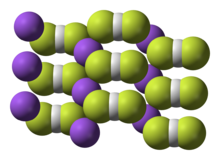Sodium bifluoride

| |
| Names | |
|---|---|
| IUPAC name
Sodium bifluoride
| |
Other names
| |
| Identifiers | |
3D model (
JSmol ) |
|
| ChemSpider | |
ECHA InfoCard
|
100.014.190 |
| EC Number |
|
PubChem CID
|
|
| UNII | |
| UN number | 2439 |
CompTox Dashboard (EPA)
|
|
| |
| |
| Properties | |
| Na[HF2] | |
| Molar mass | 61.995 g·mol−1 |
| Appearance | white solid |
| Density | 2.08 g/cm3 |
| Melting point | 160 °C (320 °F; 433 K) (decomposes) |
| Hazards | |
| GHS labelling: | |
 
| |
| Danger | |
| H301, H314 | |
| P260, P264, P270, P280, P301+P310, P301+P330+P331, P303+P361+P353, P304+P340, P305+P351+P338, P310, P321, P330, P363, P405, P501 | |
Except where otherwise noted, data are given for materials in their standard state (at 25 °C [77 °F], 100 kPa).
| |
Sodium bifluoride is the
Reactions
Sodium bifluoride dissociates to hydrofluoric acid and sodium fluoride:
- Na[HF2] ⇌ HF + NaF
The reverse of this reaction is employed to remove HF from elemental fluorine (F2) produced by electrolysis.[4] This equilibrium is manifested when the salt is dissolved and when the solid is heated. Characteristic of other bifluorides, it reacts with
Production
Sodium bifluoride is produced by neutralizing waste hydrogen fluoride, which results from the production of superphosphate fertilizers. Typical bases are sodium carbonate and sodium hydroxide. The process occurs in two steps, illustrated with the hydroxide:[4]
- HF + NaOH → NaF + H2O
- HF + NaF → Na[HF2]
Sodium bifluoride reacts with water or moist skin to produce
Applications
The main role of sodium bifluoride is as a precursor to sodium fluoride, millions of tons of which are produced annually.[4]
Cleaning agents and laundry sours
The compound also has applications in cleaning, capitalizing on the affinity of fluoride for iron and silicon oxides. For example, formulations of sodium bifluoride are used for cleaning
Other applications of sodium bifluoride include as laundry sours.[4]
Other uses
Sodium bifluoride has a role in the process that is used to
Sodium bifluoride also aids in the precipitation of calcium ions during the process of nickel electroplating. The compound also aids in increasing the corrosion of resistance of some magnesium alloys.[10]
Precautions
Sodium bifluoride is
Exposure to sodium bifluoride repeatedly or over a long time can result in fluorosis. Sodium bifluoride is not known to be carcinogenic.[3]
Biological and environmental role
Sodium bifluoride does not
References
- ^ Product Safety Summary (PDF), retrieved June 17, 2013
- ^ Perry, Dale L.; Handbook of Inorganic Compounds; CRC Press (2011); page 381; [1]
- ^ a b c d e f Product Safety Data Sheet (PDF), retrieved June 17, 2013
- ^
- ^ Sodium Bifluoride NaHF2, retrieved June 28, 2013
- ISBN 9780470523308, retrieved June 29, 2013
- ^ http://www.solvaychemicals.us/SiteCollectionDocuments/sds/P19043-USA.pdf[permanent dead link]
- ^ Sodium Bifluoride, October 14, 2010, retrieved June 26, 2013
- ^ Sodium Bifluorite, Solid, 2012, retrieved June 26, 2013
- ISBN 9780470660751, retrieved July 1, 2013
- ^ Material Safety Data Sheet Sodium bifluoride MSDS, October 9, 2005, retrieved June 13, 2013
